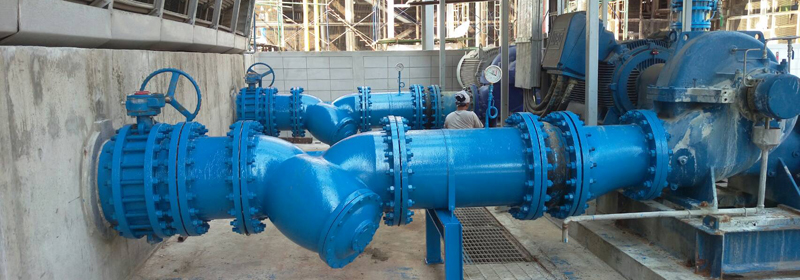At present, valves are widely used in various industries and play an important role in achieving the goal of industrial automation. Each valve has its own characteristics and technical parameters. Below we will share 8 points knowledge about valves to you.
1. What is the flow coefficient C, CV, KV value of the regulating valve?
The flow capacity of the control valve is expressed by the flow coefficient.
1) Engineering unit system CV definition: When the regulating valve is fully open, the pressure difference between the front and back of the valve is 1kgf / cm2, and the number of cubic meters of water passing through at 5 ~ 40℃ per hour.
2) Inch system definition C: When the regulator valve is fully open, the pressure difference between the front and rear of the valve is 1bf / IN2(1 degree 60. F of water per minute through the United States Gallon.
3) International system of units KV: When the regulating valve is fully open, the pressure difference between the front and rear of the valve is 100 KPA, and the number of cubic meters of water passing through the valve per hour at 5 ~ 40℃
CV = 1.17 KV
Kv = 1.01 C
2. What part of the actuator output force is required to satisfy the regulator?
1) To overcome the static unbalance force on the valve core.
2) Provide tight pressure for seat load.
3) Overcoming filler friction.
4) Additional forces required for a particular application or structure (e.g. bellows, soft seals, etc.) .
3. What are the flow opening and flow closing of the regulating valve?
It is the direction of the flow of the medium, and the role of the regulating valve gas open, gas closed. Flow Direction is important because it affects stability, leakage, and noise.
Definition: In the throttling port, the media flow direction and valve open the same direction called flow open: on the contrary, called flow closed.
4. Which Valves require flow direction selection? How to choose?
Single-seal type of control valve such as single-seat valve, high-pressure valve, no balance hole of the single-seal sleeve valve to choose the flow direction.
Flow open, flow close each has advantages and disadvantages. The valve of flow-open type works stably, but its self-cleaning performance and sealing ability are poor, and its life is short.
Single seat valve, small flow valve, single sealed sleeve valve usually choose flow open, when erosion or self-cleaning requirements can choose flow close. Two-position quick-open characteristic control valve.
5. What are the three main factors that should be taken into account in selecting an implementing agency?
1) The output of the actuator should be larger than the load of the regulating valve and should match reasonably.
2) When checking the standard combination, whether the allowable pressure difference stipulated by the regulating valve meets the technological requirements. When the pressure difference is large, the unbalance force on the valve core should be calculated.
3) Whether the response speed of the actuator can meet the requirements of the process operation, especially the electric actuator.

6. What are the 6 steps to determine the valve size?
1) Determine the computational flow — Qmax, Qmin
2) To determine the calculated pressure difference — to select the value of resistance ratio s according to the characteristics of the system, then to determine the calculated pressure difference (when the Valve is fully open)
3) Calculation of flow coefficient — select suitable calculation formula chart or software to calculate Max and Min of Kv
4) KV value selection — according to the Max value of KV in the selected product series the nearest one grade KV, get the primary selection caliber
5) The opening of Qmax —— The opening of Qmax 90% valve and 10% opening of Qmin
6) Determination of caliber-re-check if the KV value is not qualified.
7. What are the auxiliary devices (accessories) for pneumatic control valves? What’s the role of each?
1) Valve positioner-used to improve the performance of the control valve to achieve correct positioning;
2) Valve position (stroke) switch-shows the upper and lower stroke working positions of the Control Valve;
3) Pneumatic Valve — keep the valve in position when the air source fails;
4) Solenoid valve-to achieve the automatic switching of gas path. Single gas control with two-bit three, two-bit five-way;
5) Manual Mechanism — Manual operation can be switched in case of system failure
6) Pneumatic Relay – To speed up the action of the pneumatic film actuator and reduce the transfer time;
7) Air filter and pressure reducer — used for air source purification and pressure regulation;
8) Gas tank-gas source failure, so that the valve can continue to work for a period of time, usually need three protective time with.
8. What circumstances should a valve positioner be used?
1) Where friction is high and precise positioning is required, such as high temperature or low temperature control valves or valves with flexible graphite packing;
2) The slow process needs to improve the response speed of the control valve. For example, temperature, liquid level, analysis and other parameters of the control system.
3) Where the output force and the cutting force of the actuator need to be increased, for example, the single-seat valve with DN ≥25, the double-seat valve with DN > 100, the pressure drop at both ends of the valve △ p > 1 MPA or the inlet pressure p 1 > 10 MPA.
4) It is sometimes necessary to change the form of gas opening and gas closing in the course of the operation of the sectional control system and the control valve.
5) Where the flow characteristics of the control valve need to be changed.
Post time: Jul-28-2021




